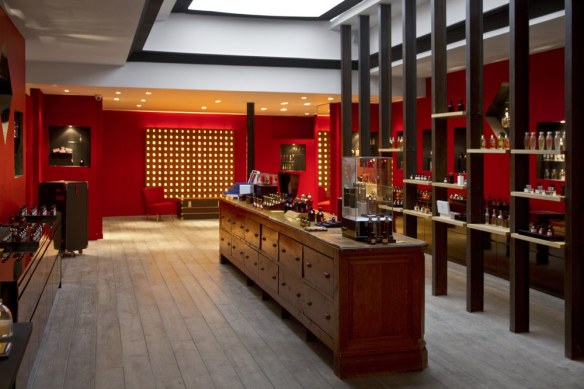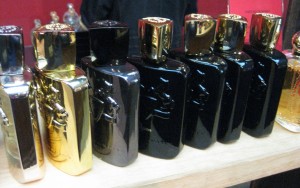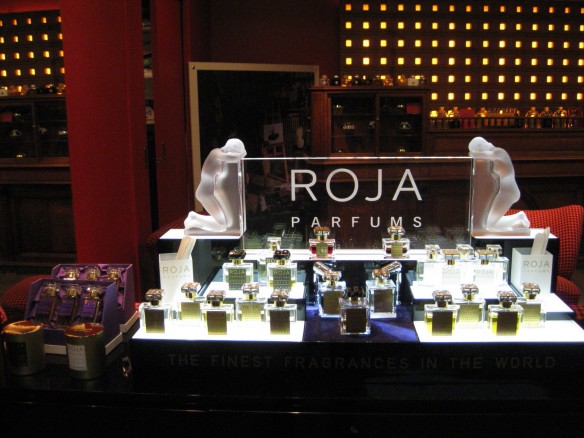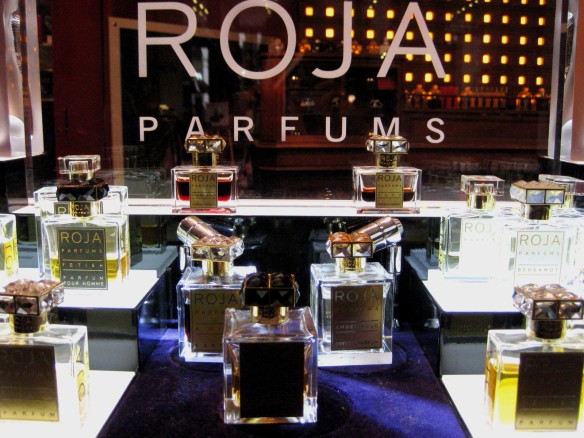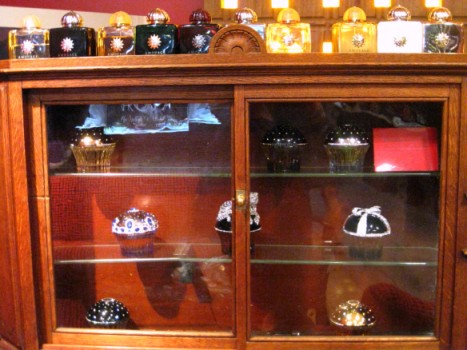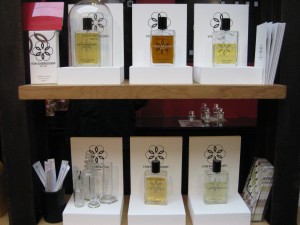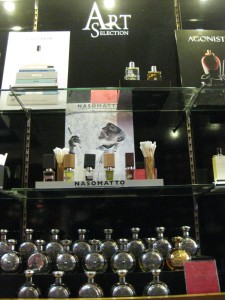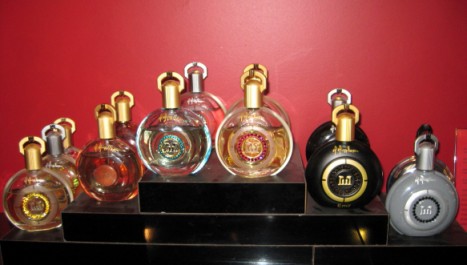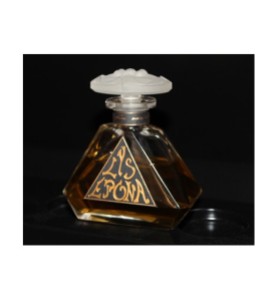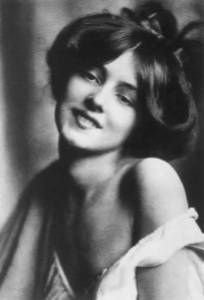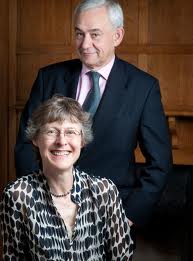If you had one day to shop for perfumes in Paris, and wanted to experience the absolute widest possible range of niche perfumes, there is really only one place to go: Jovoy Paris. It’s a surfeit of riches and treasures that is located in the Rue de Castiglione, about a block away from the Place Vendome (as well as some of the chic-est parts of Rue St. Honoré).
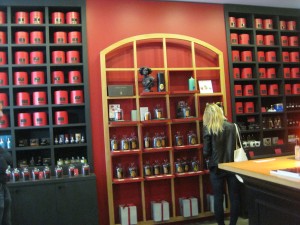 In fact, the vastness of their range makes it a one-stop shopping destination that a true perfume lover absolutely has to visit. Sure, you could always go to the beauty sections of the large departments stores like Printemps and Les Galleries Lafayettes, but you wouldn’t be exposed to the very highest end of the niche perfume world, nor to some of the smaller, rarer, more unusual or high-quality perfume treasures. Instead of focusing on brands like By Kilian, Jovoy has things like Roja Dove, Puredistance, LM Parfums, Neela Vermeire, and many other fantastic brands that it — and it alone — carries in Paris.
In fact, the vastness of their range makes it a one-stop shopping destination that a true perfume lover absolutely has to visit. Sure, you could always go to the beauty sections of the large departments stores like Printemps and Les Galleries Lafayettes, but you wouldn’t be exposed to the very highest end of the niche perfume world, nor to some of the smaller, rarer, more unusual or high-quality perfume treasures. Instead of focusing on brands like By Kilian, Jovoy has things like Roja Dove, Puredistance, LM Parfums, Neela Vermeire, and many other fantastic brands that it — and it alone — carries in Paris.
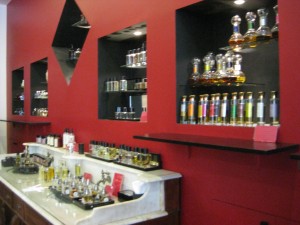 I dragged my exhausted self to Jovoy almost at the tail end of my trip, and with the warning of one Paris perfumista ringing in my head that Jovoy has almost too much stuff. It’s true. It absolutely does. But what a sensory delight from start to finish! Even on the most initial, concrete levels of visuals, Jovoy is lovely. The walls are decorated in a chic Chinese red and the furniture is black. I’m quite biased, I must admit, as that is the pairing for my library/office, and black is my favorite colour (non-colour?) in general. Still, Jovoy is a study in chic sleekness and elegance from a mere decor perspective.
I dragged my exhausted self to Jovoy almost at the tail end of my trip, and with the warning of one Paris perfumista ringing in my head that Jovoy has almost too much stuff. It’s true. It absolutely does. But what a sensory delight from start to finish! Even on the most initial, concrete levels of visuals, Jovoy is lovely. The walls are decorated in a chic Chinese red and the furniture is black. I’m quite biased, I must admit, as that is the pairing for my library/office, and black is my favorite colour (non-colour?) in general. Still, Jovoy is a study in chic sleekness and elegance from a mere decor perspective.
My photos cannot do it justice, and, once again, I have to repeat what I’ve said elsewhere: my camera chose Paris to start dying, though I now wonder if it’s perhaps just my batteries that may be the problem, despite nightly charging. Either way, my little, conveniently pocket-sized Canon seemed to be having a tantrum in photographing a lot of perfume bottles in a large number of stores (but, oddly, not a single problem at all in photographing French cheeses somehow……). From blurriness, to strange lighting, to actual zig-zag lightning strikes in neon colours, the perfume images were often wholly unusable. The ones that weren’t still aren’t fantastic. The situation seemed worst of all in Jovoy, so I can only apologise to you and to Jovoy for the quality of some of these. I include them only to give you a sense of the sheer enormity of the brands they carry, as well as a feel of that day.
So, you’ve entered the chic, sleek, minimalistic Asian-influenced environs of Jovoy, and then you see the range of the brands they carry — and your mind is effectively blown. Where do you start? How do you cover everything? None of the pictures I had seen of Jovoy had adequately conveyed the extent of all the unusual brands here. There is SO MUCH stuff! Even the tiniest of shelves has one full range crammed in; every bottle of Parfums de Marly in a tight row, one after another. And that’s only one of the tiny shelves! Jovoy is a wonderful problem for a perfumista to have, but it does also require a few practical considerations before you go.
First, if I may suggest, you should put aside at least a solid two hours — at a bare minimum — for a visit to Jovoy; and if you’re a hard-core perfume addict who hasn’t had much concrete access to testing many, less-accessible lines in person, then perhaps more like four hours. At a minimum. That was approximately the amount of time that I spent in the store, and I tell you without any hyperbole at all that I may have sniffed or tested only a mere fraction of their stock. Maybe 10%. I could have spent six hours in Jovoy, and probably still wouldn’t have had the chance to get through everything. Plus, even if you could get through it all, you would have such olfactory fatigue by the end that I’m not sure you could really process it all. I certainly couldn’t. Again, all of this is a wonderful problem to have. I’m merely warning you that you will have a sensory overload from the sheer range of perfume brands that they have, and that you should plan accordingly.
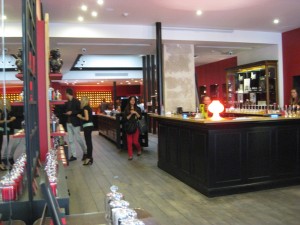 Second, I think you really need to dress carefully for Jovoy — and I’m not talking about the quality or expensiveness of your attire. I highly doubt that they give a damn. But, you need to wear clothing that will give you the easiest amount of access to as much of your skin as is socially acceptable to be shown in public without getting arrested. And wear layers, because you will run of skin real estate — extraordinarily quickly given the amounts of perfume brands they carry — so you may need fabric upon which to test some of the perfumes that really catch your attention. Even after all that, you’re still likely to be screwed for all the reasons listed up above. There still will be stuff that you don’t get to test or try, that you loved on paper, or that the perfume strips simply didn’t adequately convey.
Second, I think you really need to dress carefully for Jovoy — and I’m not talking about the quality or expensiveness of your attire. I highly doubt that they give a damn. But, you need to wear clothing that will give you the easiest amount of access to as much of your skin as is socially acceptable to be shown in public without getting arrested. And wear layers, because you will run of skin real estate — extraordinarily quickly given the amounts of perfume brands they carry — so you may need fabric upon which to test some of the perfumes that really catch your attention. Even after all that, you’re still likely to be screwed for all the reasons listed up above. There still will be stuff that you don’t get to test or try, that you loved on paper, or that the perfume strips simply didn’t adequately convey.
Perhaps some of my personal difficulty stems from the fact that I have never been able to get a really good sense of a perfume from a mere strip of paper. It’s easy to know which ones you can immediately discount and ignore, but that’s the absolute lowest threshold and bar. What about the ones you think you may like, but are unsure? Or the ones that you really like, but are not sure you absolutely love as much as some of the others? What happens when, towards the end and almost on your way out the door, you stumble across something that takes your breath away on paper, but you have no idea how it will be on your skin (or how long it will last) because you can’t strip to your underwear to find more space on which to test it? As I said, Jovoy has too much stuff — and most of it is amazing.
So, now, onto my actual experiences at Jovoy. I walked in without much of a plan except, first and foremost, to try Roja Dove‘s famous perfumes, then perhaps Von Eusersdorff‘s Patchouli. One thing that I liked about shopping at Jovoy is that they left you in peace and quiet to explore, without pestering you, though there were always assistants close-by to help you immediately if you asked. That is really my ideal way of shopping; to perambulate and see what intrigues me, pick up a bottle here or there to spray on a paper strip, and then go from there.
Another wonderful thing about Jovoy is that paper strips are conveniently and discretely placed next to each and every single brand display. No hunting around for mouiellettes, and, even better, no hunting around for a pen with which to write down the name of the sprayed perfume. No, Jovoy thoughtfully places pencils immediately on hand and throughout the store for you to use in remembering which strip contained which perfume. It a practice that that I wish more perfume stores would follow because, for most of my trip, I had started sticking pens in the back pocket of my jeans, in my leather jacket, and even behind my ear at one point. (I would often come home with over 15-20 paper strips a day, winnowed down from about 50+ things that I’d sniffed or sprayed on paper, and I tell you, you need an easily accessible pen or you’ll be lost!)
The minute I walked in, I was greeted by a smile from one assistant, but I knew exactly where I was heading. My eye went straight to the lit, highlighted Roja Dove display at the far end. Even before I’d left for Paris, a blog friend had told me about the supposed gloriousness of Roja Dove’s Diaghilev chypre, and its old-style luxuriousness, opulence, and elegance. I also knew, however, that it was €990 for a small bottle, which translates to more than $1330. Some luxury perfume brands have stratospheric prices, but the Roja Dove ones are in another galactic solar system entirely. I know he’s considered one of the most famous, legendary noses in the world, but bloody hell!
Still, it’s free to sniff, right? So I did, and I liked Diaghilev. But I wasn’t blown away, and certainly not enough to try it on my skin. (Besides, what was the point at €990?!) So, what should I try? There were so many bottles, all gleaming in the light with a vast number having lids heavy with crystals. To my relief, there was a wonderful, thin, hard-bound book to the side that described each scent and its notes, and I used it to get an idea of where I should start. Honestly though, even after reading the book, I was still at sea — what with his pure absolute Extraits of florals like gardenia and lilac, his regular line of eau de parfums, and their pure parfum versions. Making matters even more complicated is that the exact same perfume comes in a Men’s and Women’s version.
 I liked description and notes listed for Dove’s leather chypre, Fetish, so I tried both gender versions in Parfum concentration. (It comes in an Eau de Parfum as well, but I couldn’t deal with trying three variations of the same perfume!) According to Fragrantica, the notes for Fetish for Men are: bergamot, lemon, lime, fig, jasmine, neroli, violet, cardamom, cinnamon, elemi, oakmoss, patchouli, pepper, vetiver, ambergris, benzoin, castoreum, labdanum, leather, musk and vanilla. Phew, that’s quite something, especially by today’s standards where all too many fragrances have between 3-6 notes. (Hello, Jean-Claude Ellena! Hello, Montale!) The Fetish for Women is more floral and is perhaps even lovelier, though I have to give both a good test to make up my mind as to which one I prefer. The women’s Fetish includes: rose, ylang-ylang, jasmine, tuberose, galbanum, cinnamon, cloves, cedar, oakmoss, patchouli, vetiver, castoreum and musk. They’re both pretty — and pretty costly, too, at €395 for 50 ml, but at least they are pure parfums.
I liked description and notes listed for Dove’s leather chypre, Fetish, so I tried both gender versions in Parfum concentration. (It comes in an Eau de Parfum as well, but I couldn’t deal with trying three variations of the same perfume!) According to Fragrantica, the notes for Fetish for Men are: bergamot, lemon, lime, fig, jasmine, neroli, violet, cardamom, cinnamon, elemi, oakmoss, patchouli, pepper, vetiver, ambergris, benzoin, castoreum, labdanum, leather, musk and vanilla. Phew, that’s quite something, especially by today’s standards where all too many fragrances have between 3-6 notes. (Hello, Jean-Claude Ellena! Hello, Montale!) The Fetish for Women is more floral and is perhaps even lovelier, though I have to give both a good test to make up my mind as to which one I prefer. The women’s Fetish includes: rose, ylang-ylang, jasmine, tuberose, galbanum, cinnamon, cloves, cedar, oakmoss, patchouli, vetiver, castoreum and musk. They’re both pretty — and pretty costly, too, at €395 for 50 ml, but at least they are pure parfums.
Another one I liked was Roja Dove’s Innuendo, which I believe I smelled in pure Parfum version as well. The notes, according to Fragrantica, include: bergamot, lemon, orange, lemon verbena, jasmine, may rose, violet, ylang-ylang, patchouli, sandalwood, labdanum, musk, orris root and tonka bean. Lordie, was that pretty! I was significantly less moved, however, by the Roja Dove’s Extrait fragrances which are soliflores in nature, like Vetiver, Gardenia, Neroli and the like. One of them was okay, though I can’t recall now if it was the Gardenia or Lilac, and, to be frank, some of that whole Roja Dove experience is a bit of a blur now. I didn’t try every single one of the absolutes, primarily due to being completely overwhelmed, but generally, I wasn’t hugely moved by those I did sniff. I most certainly was NOT moved enough for the price of the bottle, which is around €325!
I also wasn’t passionate about the two Roja Dove ouds I tried, Aoud and Amber Oud. They were fine, though I didn’t think either one was extraordinarily special, and one had far too much saffron for me. As a perfume blogger, I’ve reached critical saffron-oud overload, which is a shame as the spice used to be one of my favorite notes. Clearly, it’s not the perfume’s fault, and is a matter of personal tastes. One thing was unquestionable, however, and that was the gorgeousness of the cranberry-red juice for the Amber Oud. Really lovely.
After Roja Dove, I went next to one of the bookcases in the center with its wide variety of different brands. I was thrilled to see Parfums de Marly, a line about which I’d heard much talk. It is now available in the US at OsswaldNYC, but I don’t live in New York and have no immediate access, so to get to try it leisurely here was exciting. I intentionally eschewed the perfumes that seems to get the most fuss, Herod, because when a company actually and officially lists ISO E Supercrappy (™ Sultan Pasha) amongst its notes, I know it’s best for me to steer very clear indeed. (Seriously, can you imagine how high the percentage of that olfactory carrion vulture must be for Parfums de Marly to have to list it officially?!) All the other bottles appealed to me, but I didn’t know where to start. There were also no notes listed anywhere, and I didn’t want to ask someone because I preferred to be left alone.
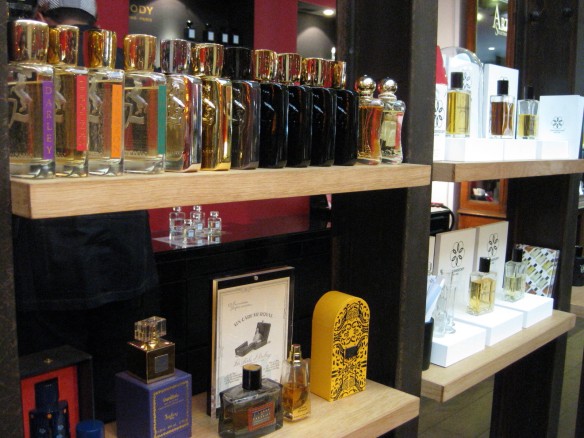
Parfums de Marly on the top shelf with Safanad as the second glass bottle from the right side of the frame. Isabey perfumes are on the bottom shelf. Far right is Von Eusersdorff on both top and bottom.
So, at random, I just picked up one of the smaller, clear, non-opaque or coloured bottles that was to the far right, and sprayed a little. WOW! Glorious, simply glorious. I couldn’t find a name on the bottle (which I thought was quite odd), so I asked one of the sales ladies who was equally perplexed. Finally, on the bottom and in tiny font, we saw the name. The perfume turned out to be Safanad which according to Fragrantica is a 2013 Floral Woody Musk whose include: orange, pear, orange blossom, ylang-ylang, iris, amber, sandalwood and vanilla. Really gorgeous. It’s an eau de parfum that comes in an 75 ml bottle and costs €159.
I ambled around further after that, smiling at the chic Puredistance display in one corner, admiring the wall of Amouage elsewhere, and trying to figure out who on earth made the perfumes that were in some very fancy, glittering orbs and locked behind glass. It turns out, it was a line called House of Sillage.
Then, I stood gulping in abject awe at the Baccarat-and-gold bottles of Grossmith‘s original, historical line under glass. I had previously tested and reviewed Grossmith’s Phul-Nana, which is a simply gorgeous, opulently Victorian, lusty and spicy orange blossom, neroli, tuberose, ylang-ylang and woody fragrance. At the time of its release, back in the 1880s, it had been the Chanel No. 5 of its day, and I loved its faithfully translated modern version. In that review, I’d written about the famous Baccarat bottles which were created with the help of various Middle Eastern royal families and whose price tag is astronomically high, so to now see them in person…. I was thrilled! It is just as well that they were locked behind glass, because I would probably have stroked them with lust like a crazy person.
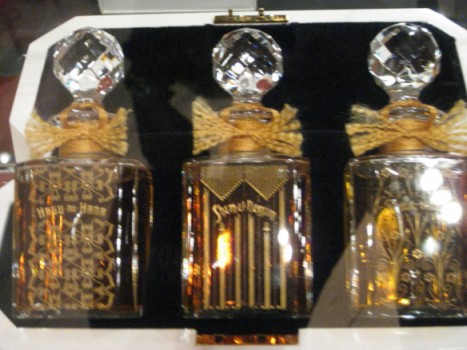
Grossmith’s baccarat flacons of the original trio in the line. I’m so sorry about the poor photo quality!
Later on, I had the chance to smell a Grossmith scent which I had previously eschewed testing because I had heard that it was very powdery — and I don’t do powder! It was Shem-el-Nessim, which Fragrantica classifies as a Floral Woody Musk with notes that include: bergamot, neroli, geranium, jasmine, rose, ylang-ylang, iris, musk, patchouli, cedar, sandalwood, heliotrope and vanilla. Good heavens, is that a beautiful perfume! And what sillage it had, too! I was fortunate to obtain a sample, and I’m definitely going to do a full review down the road, but I have to say now, it was truly an opulently luxurious scent in the very best of the old-time tradition from the golden age of perfumery. I’m really glad that Roja Dove helped Grossmith to recreate its ancient classics, because I think the perfume world is far better for it. Now, if only they were more easily accessible….
Eventually, I made my way to the far right wall where I came across Jovoy‘s own line of perfumes. As always, my problem was knowing where to start, and I already had about 13 paper strips in my hand at this point. (And those are the ones that I had not discarded!) I tried Gardez-Moi which was a lovely white flower bomb, but then what? I went by colour, knowing that the darker the juice, the more likely it would be a woody, spicy or oriental fragrance which is my personal, preferred category. I started with Psychedelique because of the name, and it turned out to be an intriguing patchouli.
Previously, however, I’d tried another patchouli — Classic Patchouli from Von Eusersdorff — which had come highly recommended by another blogger, Susie of Scent Epiphany. I was unsure about both of them, not because they weren’t excellent (they were), but because I’m on the hunt for a very particular patchouli scent. Perhaps more to the point, I simply didn’t dare put two different ones on my skin, lest patchouli’s generally forceful characteristics overwhelm everything else that I may want to try down the road.
Then, my eye was caught by Jovoy‘s Private Label fragrance with its dark, cognac-coloured liquid. It was a woody oriental which smelled of vetiver, amber, leather and, oddly enough, a sort of chilly peppermint that was exactly like that in the American candy, York Peppermint Pattie. I was intrigued by how it conjured up warm winter comfort from its initial whiff, and thought it definitely required further testing. I didn’t try any more from the line and, now, in hindsight, I wish now that I had been clear-headed enough to sniff Jovoy’s Rouge Assassin. Alas, Jovoy had scrambled my brain, so I completely blanked out, and sadly missed my chance.
There were so many bottles within each line, and so many paper strips in my hand, that I decided it was time to seek help. I made my way to a very tall, youngish chap with dark hair who seemed to be the manager. It turned out that he was one of them, but also, the brother-in-law of François Hénin, Jovoy’s owner. Mr. Hénin wasn’t there that day, but Léon took good care of me, even before he found out I was a perfume blogger. Prior to that point, he seemed initially a bit mystified by my rather endless series of questions about the specific notes in different perfumes (and he blinked at my intense, forceful hostility to the ISO E Super that I detected in one fragrance), but he caught onto my tastes quite quickly and steered me to a few things I liked.
Generally, though, he politely and courteously followed my lead in pursuing the specific fragrances I was curious about. By now, I had about 18 paper strips in my hand that I had narrowed down to about 7 that I wanted to try on my actual skin. We went through those 7, but he also pointed me to a few other things. It was actually thanks to Léon that I tried the fantastically diva-ish, seductive Grossmith Shem-el-Nessim, when I would have otherwise discounted it from talk that I had heard about its ostensibly powdery nature. (It wasn’t on my skin, though I haven’t yet had the chance to do a full, thorough test of it.) Léon also pointed me to specific Amouage scents that he thought would appeal to my tastes, and to Puredistance M which, unbeknownst to him, is actually one of my favorite perfumes. (It was around this time that I had to explain that I was familiar with many fragrances in question because I was a perfume blogger, had reviewed them, and/or owned them.)
I hesitated to ask for samples because of the number of things that I was really intrigued by, but Léon was more than generous. I’m extremely grateful to him and to Jovoy, because the simple reality of my skin’s wonkiness is that I need samples to get a sense of a perfume. I can’t really get proper idea of a perfume from paper strips, there is only so much space for spraying perfumes, and, most importantly of all, I have absolutely voracious perfume-eating skin.
In short, it is completely impossible for me to buy a perfume without a sample to test its layers, its sillage and how long it may last. I was disappointed, for example, that the gorgeous Parfums de Marly Safanad had already faded substantially in projection before I had even left the store! The Roja Dove Fetish leather perfume also seemed much more intimate on the skin, though I think some of that may have been olfactory fatigue. While the Grossmith Shem-el-Nessim went strong for hours, there were a number of scents that I had really liked but had no space to try on my skin at all. So, samples were essential.
And samples, I got — without a murmur or raised eyebrow. From Roja Dove, to Safanad, two fragrances from Jovoy’s own line, and a few others. I had heard from one blogger that Jovoy was “stingy” in giving samples, even upon the purchase of a fragrance, but that was not my experience at all. As Léon was calmly spritzing things into vials, I espied the new Histoires de Parfum fragrance, 1899, devoted to Ernest Hemingway, at one end of the counter. I like Histoires de Parfum quite a bit as a brand, but rather loathe Ernest Hemingway for his personal life and character, and I have never been particularly impressed by his writing with the (perhaps understandable) exception of A Moveable Feast which focuses, in part, on Paris. Still, Histoires de Parfums was going to take on Hemingway, and put his essence in a bottle?! This I had to try! I wasn’t impressed by my initial sniff, but as we’ve already discussed, paper strips can go fly a kite in terms of usefulness and true accuracy! So, we shall see how it actually turns out.
Léon kindly gave me permission to take photographs for the blog. I was on my way out of Jovoy when I began taking pictures, but I came across so many cool things that I had to start sniffing all over again! There were things that I had initially missed, like Xerjoff‘s new collection, Join The Club. The few I tried from it were merely average, in my opinion, though I didn’t give the full range a thorough sniffing. (There were so many of them!) Then, I admired the endless, pretty, and sometimes bejewelled, bottles of M. Micallef, and seemingly all or most of the Boadicea the Victorious line. My God, so many of the latter! I didn’t pick up a single one because I didn’t know where to start! I was also a bit at sea when it came to the large Fueguia 1833 line from South America. I’d heard much about it, but I was starting to experience olfactory fatigue to match my physical one. So I gave two bottles some half-hearted sniffs, then gave up and returned to my photographs.
All around, there were bottles from perfume houses that I knew and/or had previously reviewed. To name a few: Frapin, Lubin, Juliette Has A Gun, Aedes de Venustas, Nobile 1942, David Jourquin, Heeley, M. Micallef, Tauer Perfumes, Vero Profumo, Ys.Uzac, and a blast from the past in the form of Jacques Fath and Revillion.
I was in the midst of full olfactory (and visual) overload when I saw lines that I’d heard other perfumistas talk about, but had never had the chance to try: Isabey, Andrea Maack, Humiecki & Graef, Czech & Speake, Majda Bekkali, Juls et Mad, SoOud, E. Coudray, Miller Harris, Evody, Sospiro, Ann Gérard, Brécourt, Undergreen, and… good lord, there were so MANY!
Finally, there were perfume brands that I’d never heard of at all, leaving me blinking at their bottles like a deranged owl. To name just a few: Steve McQueen (?!), House of Sillage, Philly & Phil, Eight & Bob, Amorvero Profumo, Arty Fragrance by Elisabeth de Feydeau (a French historian whose line is inspired by the palace and life at Versailles), Arte Profumi, Lostmarc’h (yes, it’s apparently spelled that way, and no, that is not a typo), Testa Maura, Hors La Monde, Mendittorosa, and Alexandre J. Can you see why Jovoy requires at least a whole day’s exploration to really have a chance to cover even a small portion of their stock? Below are some thumbnails that you can expand to see a bit more of the Jovoy selection, but even these photos are hardly the complete story.
Speaking of Alexandre J., the latter’s bottles actually stopped me dead in my tracks. In the middle of my photographing, I suddenly saw gleaming mother of pearl! A solid, massively heavy, hefty bottle of white mother of pearl, and then a truly spectacular grey-black one. I took some photos of the accompanying book that explained a little of the supposedly unusual technique, process, and quite original look of the perfumes, but I really couldn’t get a good sense of the exact notes. The white one was for women, that much was clear from the book, and the grey-black one was the men’s version with somewhat different notes, but what were they exactly? The book didn’t say, at least not from what I saw.
I had to go get Léon, who merely grinned at me at this point and asked if I’d like to have an expresso. I laugh at the memory of it, because it was so clear (to both of us) that I was going to be there for the long haul, and that there was no way I was going to be able to drag myself out of Jovoy for a few more hours. While he left to kindly make me an expresso, I noticed a some more brands that caught my eye including a bottle in a steam trunk called Lys Epona. I picked up the stopper, dabbed it on a paper strip, and blinked. Good God, that was fantastic!
Léon had returned at this point with my much-needed dose of concentrated caffeine, and I asked him about both brands. Alexandre J. seems to be a French designer who apparently seems to be interested in history, art, and luxury craftsmanship. The perfumes that had caught my eye were called Legacy, White and Black. Each of those 100 ml mother of pearl bottles took over 200 hours to make, polish, enamel and inlay, and it was all done by hand. That explains the €495 price tag which translates at the current exchange rate to around $677. I wasn’t impressed by the white one which seemed to be an incredibly light, bland, unoriginal fruity-floral, but the darker woody-musk aroma of the grey-black one was okay. However, I didn’t think either one was original, different or luxurious enough in smell for me to really bother.
More to the point, I was still haunted by the beauty of Lys Epona. I had found one tiny, miniscule square of untainted, virgin skin on which to dab a little, and I was transfixed by the aroma wafting over me. So, upon his return, I dragged poor Léon to the large, rather old, classic steamer trunk in whose top shelf the old-fashioned (in a fantastic way!) bottle of Lys Epona with its almost Lalique-looking top lay nestled. “What is that??!” I demanded.
Léon explained that it had been created by Amelie Bourgeois (who had also created Jovoy’s much praised Rouge Assassin) in conjunction with François Hénin of Jovoy. The scent is considered to be part of Jovoy’s own perfume line, and is exclusive to the store. I have the impression that there are only a hundred bottles made, due to a comment made by Surrender to Chance on their website, but I’m not certain on that point and I don’t recall Léon saying that it was limited in nature.
Jovoy’s website categorizes Lys Epona as a “leather” eau de parfum whose notes include lily. There is nothing else really mentioned other than the fact that it is an eau de parfum that comes in a 65 ml size, and that it costs €225. Fragrantica says its notes are: bergamot, lily, ravensara, narcissus, jasmine, ylang-ylang, wheat, hay, lily, musk, labdanum, tobacco and cedar. I thought it was spectacular with a floral richness and headiness that really evoked the classic style of the golden age of perfumery, and I am incredibly grateful to Léon for giving me a sample. I will review it as soon as possible, probably next week, because its potentially limited nature has got me rather going. If Lys Epona works on my skin, and lasts, it’s going to be something to consider sooner rather than later.
After Lys Epona, Léon and I walked around the rest of the store and discussed the various brands. I asked him about Amouage‘s new Fate, and was surprised to hear that it was far from being a big seller at Jovoy. I would have thought that the blogosphere and perfumista mass frenzy over Fate Man and Woman (especially Woman which I loved), along with those gorgeous iridescent bottles, would have made people rush to buy it. Apparently not. I can’t recall which Amouage is Jovoy’s biggest seller, but I vaguely remember that Beloved does very well, and I think Interlude as well. Still, I might be mistaken on the details, given both the hecticness of that visit and my exhausted state of sleep-deprivation on that trip as a whole.
While walking around with Léon, I came across a number of perfumes that I had previously reviewed. There was the new Ashoka from Neela Vermeire, and we both agreed on how great the line is as whole. I told Léon my thoughts on Nasomatto‘s sexy Black Afgano, and how it seemed to me to be a super-concentrated version of YSL‘s famous M7 in vintage form. We came across Agonist; I grimaced a little at the sight of The Infidels which, I told him, smelled exactly like Tutti Frutti or Juicy Fruit chewing gum to me. There were many more fragrances I knew well, but I had to smile at all the bottles of LM Parfums lined up, including the new-limited edition Chemise Blanche. I had met with Laurent Mazzone, the brand’s founder, just five days before for tea at the Hotel Costes, and I had gotten to try Chemise Blanche as well as LM Parfums’ upcoming releases.
Then, I came to a rather sharp, skidding halt at the sight of Comptoir Sud Pacifique‘s silver aluminum bottles near the front of the store with its wall of expensive candles. I might be a slight snob, but I don’t think the brand really fits in Jovoy, even if it’s CSP’s ostensibly “haute” niche collection with an average price of around €115. It certainly seems a slightly odd stable mate to go with the Amouage, Puredistance, Xerjoff, Neela Vermeire, Vero Profumo, Clive Christian and other lines represented in the store. (My suggestion: carry Profumum Roma‘s fabulous perfumes instead!)
Despite that last list of very respected, expensive perfumes, I would like to stress that there is something for every budget at Jovoy. There are some affordable, high-quality lines available in the store that I really like, from Parfum d’Empire to Histoires de Parfums. (The small bottles of Parfum d’Empire generally start around €66, or about $75-$80.) Jovoy also carries a perfume house that was a new discovery for me on the trip, and which I fell for very hard: Jardin d’Ecrivains. I had first come across the perfume line at Marie-Antoinette, the only other store in Paris to carry the line, and had bought one of the fragrances. It had been an enormous struggle to decide which one I had liked best because they’re all really special, unique, or just simply gorgeous! They’re also extremely reasonably priced at €85 for the large 100 size, high quality and concentration (eau de parfum). So, yes, Jovoy carries Clive Christian which prides itself on being the most expensive perfume in the world and which explicitly uses that phrase as their official (and, hence, very obnoxious and nouveau riche) company motto. But, at the same time, Jovoy also offers brands with bottles in the €66 to €87 price range. Still, I would be lying to you if I said that there are a ton of things at that lower end of the price scale, but there are some.
It was getting late at this point, and I had to meet some friends, so I reluctantly dragged myself out of Jovoy. I was scheduled to leave Paris in two days, and Jovoy was closed the next day, on Sunday, so I was even more grateful to be armed with some samples to help me make up my mind. It’s going to take me a while to go through them all for the purposes of a full, detailed review, but I know I can always turn to Jovoy. Unfortunately, I don’t think they ship to the U.S., but they do to most of Europe. (I’ve already got a mental list of Paris friends who can stop by to pick up what I may need and send it on to me themselves, or whose European addresses I can use for shipping.) If you’re in Europe, I’ve generally heard very positive things about Jovoy’s customer service, so if there is a brand that I’ve mentioned that you’ve been tempted by in the past, or if there is something I review that isn’t easily accessible in your city, you should absolutely check out the Jovoy website.
They say that the Louvre can’t be seen in any real or substantive way in just one day, and I’m going to have to add Jovoy to that list. Those who live in Paris are lucky. Those who visit are going to need to give themselves ample time to sniff. Chances are, you’ll find far more things to love than any (regular) person could ever afford. In fact, if you can easily walk out of Jovoy with only one bottle or only one thing on your wish-list, then you’re a far stronger person than I am. Short of having an unlimited budget, there will always be some treasure that beckons to you with a siren song of seduction.
One has to really applaud François Hénin for curating such an astonishing, tempting collection of such high-quality. When I think that he started Jovoy a mere three years ago in 2010, and then see all that he has done, including getting the exclusive rights to carry Roja Dove’s perfumes, I have to give a very huge, very sincere Bravo to him! He’s created such an incredibly large range of tempting, luxury perfumes that Jovoy really is more like Aladdin’s Cave. Now, I just need to find a genie to grant me all my perfume wishes.
Note: All photos are my own, unless otherwise stated.

